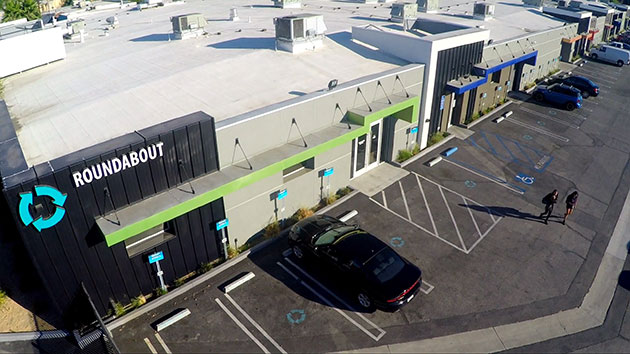
Burbank post facility Roundabout Entertainment has a head start on mastering for HDR — it's been working in HDR for more than a year, going so far as to develop a proprietary QC system for HDR media. Amazon, which streams several original series in HDR and UHD, is one of the company's clients.
HDR Workflow
Asked about the impact of HDR deliverables on workflow, Roundabout Senior Colorist Michael Smollin tells StudioDaily the key is to compartmentalize HDR in its own space rather than getting into a vicious cycle of trying to tweak different flavors of deliverable to match each other. "You're going to get a different answer from different colorists," he admits. "But my approach is to think of HDR as a different aesthetic. Even on features, you now have different versions — your P3 grade, your Rec. 709 grade, your 3D, and now your extended-range version. I like to think of the P3 as the master, your beauty version. That's the one everyone needs to lock on. You want your 3D and Rec. 709 versions to match that. But you do not want to be bouncing from P3 into your HDR or Dolby Vision version and back because you'll just be chasing your tail trying to make them match.
"You'll look at the extended dynamic range and increase your white, and that give you more shadow detail and saturation. If you say, 'I don't remember seeing that in the P3 version, so let's go adjust that,' you're changing what should be the base grade."
A first impulse might be to simply take the P3 grade and remap the colors to Rec. 2020 color space and then take a look at it in HDR. But even that basic process has a dramatic effect on color and saturation, Smollin says. "When the shadow details get deeper, that brings out more color. Chrominance gets more vibrant. Blue gets bluer, red gets redder, and green comes to life. It's not going to look like the P3 version any more because you have more detail in the files. So you want to take the ideas from the P3 version and expand on them in HDR. You can change how much the highlights ring and get more detail out of the blacks and decide just how deep you want the shadows to go. Keep in mind what you've done in P3, but don't try to make them match. It's a new version, and it's separate."
The Wild West
Problematically, HDR is still a moving target, partly because content creators haven't yet established best practices for what are still boundary-pushing images, but also because the capabilities of different HDR-capable TV sets (not to mention the viewing environments where consumers will be using them) vary so widely. "HDR right now is kind of the Wild West," Smollin says. "There's no real spec, and nothing's nailed down."
For example, Amazon places a 1,000-nit ceiling on brightness — nothing on screen in an Amazon show should exceed that level. Roundabout can easily detect when a scene is in violation, but it's not necessarily apparent how best to fix the footage to bring it back within the legal boundaries. The issues are compounded by the fact that different clients have different specs for brightness.
And then there's the consumer viewing environment, where HDR material will be viewed on a variety of different screens, only some of which meet the UHD Alliance's "Ultra HD Premium" guidelines, which specify that a screen must reach a minimum of 1,000 nits of brightness with a black level of less than 0.05 nits, or 540 nits of brightness with a black level of less than 0.0005 nits. (The latter spec is designed to address OLED screens, which aren't as bright as LCD but have lower black levels.) Virtually no sets released prior to 2016 meet those standards. "We're delivering this material for Amazon and Netflix to stream in HDR, but who's actually watching it right now?" Smollin wonders.
There are no clear guidelines, as yet, about how bright is too bright. Smollin remembers working at Walden Media on some early projects that used the ACES color workflow, including Chasing Mavericks. "Dolby reconformed it and put it on their (4,000-nit) pulsar monitor, and I got to take a look at what ACES extended-range files could look like in Dolby Vision," he recalls. "What I remember from that experience was looking at a silhouette on a beach, in front of the sun, on the monitor. Not only was the monitor giving off heat — so you had a visual experience and a physical experience — but also, [the figure] standing in front of the sun felt like a real silhouette. You were squinting at the monitor.
"In ACES, 0 is black and 15,000 is the brightest nit value you can get when you shoot on film," Smollin continues. "In what we captured as ACES Open EXR files, the brightest value we could see was something like 5,000 nits. So the code values go past what we can even imagine. You can push those levels up, but do we really want the whites that white? Do we want people to put on their sunglasses?"
Asked about the lower end of the image, Smollin said QC can detect issues in that range, too, noting that Roundabout had to repair an entire season of an Amazon show. "We didn't master it here, but when we got to QC, we found that something happened in the translation between their TIFF sequence and their QuickTime files," he said. "There can be a small translation issue because of RGB-to-YUV conversion, but if it's way off, there's an underlying issue."
Processing Power
Despite any uncertainty about aesthetics, demand for programming graded in HDR is only growing as providers seek to future-proof their content. Roundabout does its HDR color work on two Da Vinci Resolve systems connected via PCIe to Cubix break-out boxes, each with eight Nvidia GeForce GTX Titan Black GPUs. For critical viewing, Roundabout has a DI theater as well as a broadcast bay with Panasonic plasma screens and Sony BVM-X300 displays. Smollin's department is networked via fibre to about 400 TB of shared storage on DVS SANs.
And the Resolve systems do double duty on film restoration work. For example, Roundabout recently finished work on a 4K digital restoration of director Franco Zefferelli's Romeo and Juliet (1968) commissioned by Park Circus and Paramount, as well as The Friends of Eddie Coyle (1973). And Roundabout has done some work for the UCLA Library — Return of the Ape Man (1944) and some old Mighty Mouse cartoons, all on nitrate stock. (Pro-Tek Vaults or FotoKem do prep work on the nitrate prints before they arrive at Roundabout, which has a fire-protected nitrate locker on site.) Some studios provide 4K scans of their library material, but Roundabout does other scans in-house on its Lasergraphics Director archival scanner before clean-up takes place in MTI's DRS Nova.
Asked whether a 4K scan actually reveals more detail in a 70-year-old Mighty Mouse cartoon than a 2K scan would, Smollin says it's "questionable." But the real value is in future-proofing the content against the next generation of display technology. "Obviously, you're getting more pixels, but the reason for doing it in 4K is more to future-proof it," he says. "We always have to keep in mind that if we don't, we will have to do these titles again and again and again."
Did you enjoy this article? Sign up to receive the StudioDaily Fix eletter containing the latest stories, including news, videos, interviews, reviews and more.











Leave a Reply